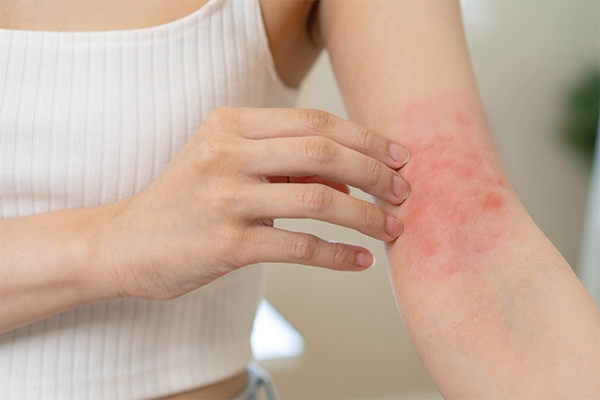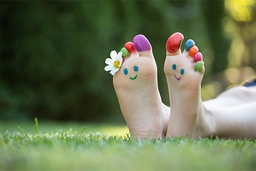Why Does Diabetes Make Your Skin Itchy?

Diabetes can affect all parts of the body, including the skin. Many diabetics no longer have skin problems after managing their blood sugar levels.
Diabetes affects many organs of the body, including the skin. One common complaint is persistent itching, despite no bumps, rashes, or allergy symptoms.
Read more: Diabetes Complications.
Itchy skin might be an early sign that blood sugar levels are out of control. Itching in persons who have not been diagnosed with diabetes can also be an early sign of prediabetes or hyperglycemia.
However, itching is not just about high blood sugar. Diabetes can also cause damage to nerve fibers in the skin's outer layer.
Diabetic polyneuropathy or peripheral neuropathy is a common complication of diabetes. It usually begins in the feet or hands. One of the first symptoms is an unusual itching sensation, like a prickling or mild burning.
Cytokines, or inflammatory substances in the body, are usually raised before a nerve injury. These cytokines stimulate the skin and cause an itchy sensation before other neuropathy symptoms appear.
Unfortunately, many people with diabetes are unaware that their skin problems are related to their blood sugar levels. According to a diabetes journal, approximately 30% of people with diabetes experience skin problems, including pruritus, a chronic itchy sensation.
Untreated itching can be severe. Constant scratching can cause the skin to grow dark, rough, and uncomfortable. If the wound is open and infected, complications can increase. That is why itchy skin should not be considered trivial.
What are the causes?

Itchy skin in people with diabetes can be caused by several factors, including
1. Allergic reactions to drugs
Some people experience allergic reactions to diabetic medication, both oral and injectable insulin. Usually, a rash, swelling (urticaria), or itching appears in the injection area or other parts of the body.
2. Bacterial infections
High blood sugar can weaken the immune system, including the skin's natural defenses. This makes bacterial infections, such as styes, boils, or carbuncles, easier. Signs can include swollen, red, hot, and painful skin. Antibiotics are usually needed for treatment
3. Dry skin and poor circulation
Diabetes often interferes with blood circulation, especially in the extremities such as the feet. Plus, high blood sugar draws fluid from the skin.
This can cause the skin to become extremely dry and itchy, especially in the lower legs. Moisturizers can help, but managing your blood sugar is crucial.
4. Fungal infections
Fungal infections are also common, especially the yeast Candida albicans. Symptoms include small, red, wet, and very itchy blisters that usually appear in body folds, such as under the breasts, between the fingers, in the armpits, in the groin, or around the nails. Fungal infections, such as athlete's foot, ringworm, or skin fold, require antifungal medication.
5. Dehydration
When your blood sugar levels are too high, your body tries to eliminate them by pulling fluid from your cells and releasing it through your urine. Dehydration can cause dry, itchy skin.
6. Kidney or liver failure
People with poorly controlled diabetes are at risk for kidney disease (diabetic nephropathy) and fatty liver disease. In severe cases, it can lead to kidney failure and cirrhosis of the liver. Both present with intense itching and other symptoms.
Tips for preventing skin problems for people with diabetes

Caring for your skin should be part of your daily routine, especially if you have diabetes. These tips can help:
- Check your skin daily: Look for signs of rashes, redness, sores, or infections, especially on your feet.
- When bathing, use warm water and a moisturizing soap. Avoid using hot water or long soaks, which can further dry your skin.
- Pat your skin dry, not rub it, especially between your toes and in body creases.
- Apply a fragrance-free moisturizer after bathing, while your skin is still damp. To keep your skin moisturized, use a ceramide-rich cream or ointment. Apply 10–25% urea cream to your cracked heels before bed.
- Prevent dehydration by drinking enough water to keep your skin hydrated from the inside.
- No matter how tiny, wounds should be treated immediately: Clean with soap and water, bandage daily, and apply antibiotic ointment as your doctor recommends. If you notice any signs of infection, such as redness, swelling, pain, or discharge, consult your doctor.
- Brisk walking, swimming, or jogging can help improve blood circulation in the lower legs and help prevent blood vessel changes that cause diabetic neuropathy.
Keep your blood sugar, keep your skin
Itchy skin can signal your body that your blood sugar levels are abnormal. By keeping your blood sugar stable, you protect your internal organs and take care of your body's "outer fortress": your skin.
So, don't take it easy on the itch. Listen to your body—sometimes, itchiness is your skin's way of talking.



